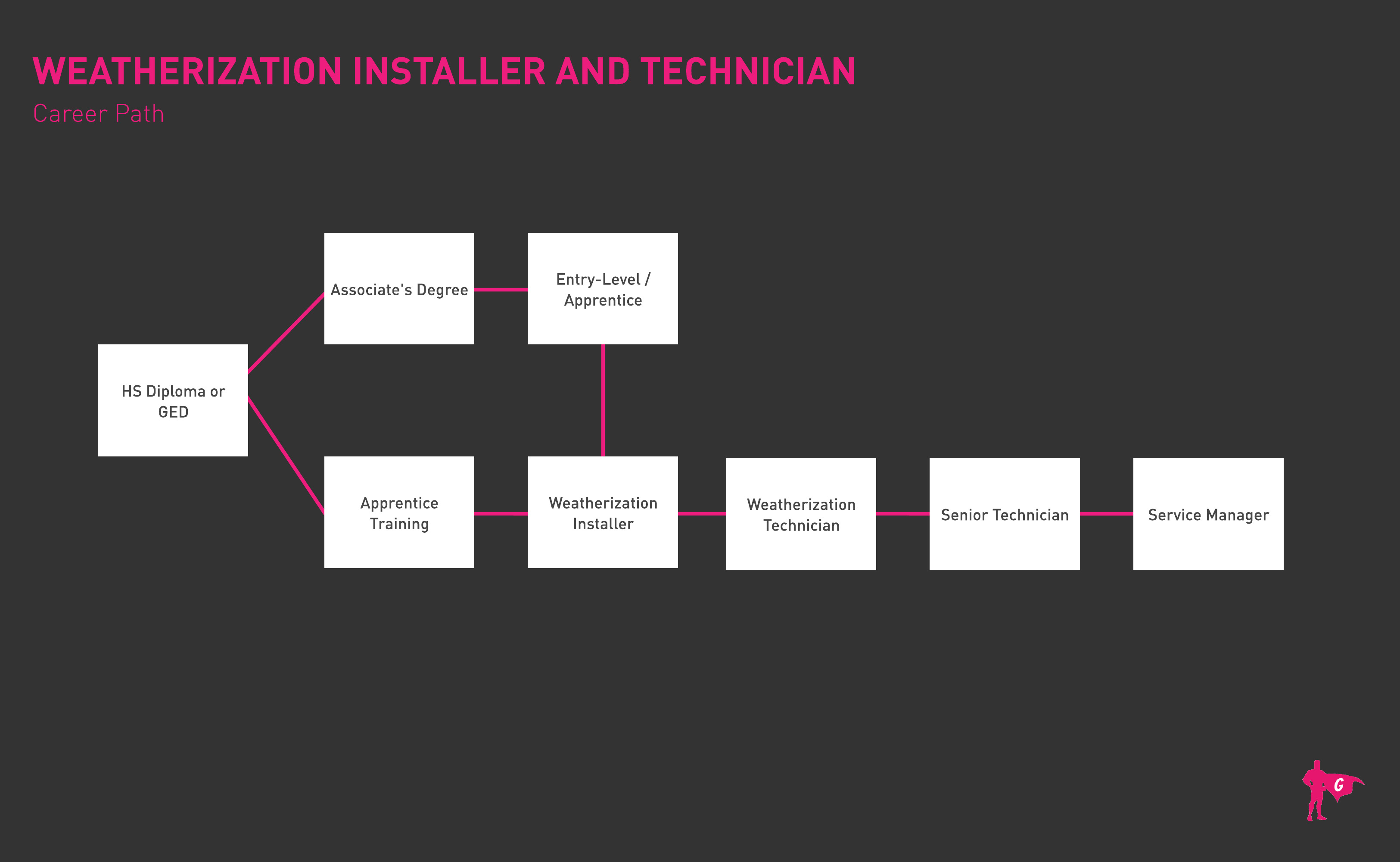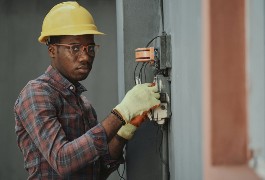Spotlights
Energy Administrator, Field Technician, Weatherization and Housing Inspector, Weatherization Installer, Weatherization Technician, Weatherization Worker
Also known as weatherproofing, weatherization is the technique of protecting buildings and establishments from all weather elements, including humidity, sunlight, and wind. Weatherization Installers and Technicians perform these techniques and make modifications to optimize energy efficiency and reduce energy consumption.
Commercial and residential energy consumption accounted for 39 percent of total energy consumption in the U.S. in 2021. Weatherization Installers and Technicians help reduce overall energy consumption when weatherproofing businesses and homes. Weatherization Installers and Technicians are also called Energy Administrators Field Technicians, Weatherization Housing Inspectors, and Weatherization Workers.
- Helping people protect their homes, businesses, and themselves from the elements
- Helping preserve energy and protecting the planet
- The opportunity to educate others on energy conservation
Working Schedule
- Weatherization Installation and Technicians typically work 8-hour shifts or 40-hour work weeks. Some additional overtime hours and weekend work may be required. They spend most of the day standing on their feet, bending or kneeling. Approximately 73 percent of Weatherization Installers and Technicians state that they work outside every day. An additional 25 percent said they work in an office setting at least once a month.
Typical Duties
- Determine the amount of air leakage in buildings and homes
- Test combustible appliances
- Use furnace efficiency analysis equipment to diagnose air flow systems
- Install and seal air ducts and any other ventilation openings to optimize cooling and heating efficiency
- Apply insulation materials to attics, basements, crawl spaces, and walls
- Inspect buildings to identify weatherization measures that need to be taken
- Recommend weatherization techniques to clients
- Prepare estimates for weatherization services
- Wrap air ducts and water lines with insulation materials
- Prepare caulking, door sweeps, glazing, and weather-stripping to prevent energy loss
- Repair holes in walls using spackling
- Maintain activity and financial transaction logs
- Install storm doors and windows
- Wrap water heater blankets around water heaters to conserve resources
- Test the functionality and quality of products and equipment
- Install green equipment or systems
- Inspect the finished project for proper installation
Additional Responsibilities
- Explain policies, procedures, recommendations, and requirements to building owners and residents
- Inform residents and business owners of energy conservation measures they can use to conserve electricity and energy further
- Assist in the preparation of bids and contracts on weatherization work
- Clean and maintain equipment, tools, and facilities.
- Contact building owners or homeowners to schedule appointments
- Record environmental data as needed
Soft Skills
- Active Listening
- Coordination
- Critical Thinking
- Decision Making
- Effective Speaking
- Installing equipment or machines that meet specific guidelines
- Monitoring your own performance as well as others
- Operation and Control
- Operations Monitoring
- Quality Control Analysis
- Reading Comprehension
- System Analysis
- System Evaluation
- Time Management
- Troubleshooting
Technical Skills
- Ability to navigate Energy auditing software
- Ability to use work scheduling software
- Customer relationship management (CRM) software (Salesforce CRM)
- Database user and query software
- Development environment software (Apache Ant Hot technology)
- Enterprise resource planning (ERP) software Hot technology
- Operating system software
- Presentation software (Microsoft PowerPoint)
- Project management software
- Spreadsheet software
- Word processing software
- Bridge and Highway Construction
- Building Construction
- Electric Power Generation and Distribution
- Government Organizations
- National Gas Distribution
- Specialty Trade Contractors
- Textile Product Mills
- Waste Management Services
Weatherization Installers and Technicians do some work outdoors but generally work indoors and in commercial and residential settings. They often work eight-hour shifts but sometimes work overtime. They bend, kneel, stand on their feet, work on ladders, or work in confined spaces for most of their day. Hand-eye coordination is a must. Strength requirements will vary by job, but some may require lifting and moving heavy objects.
Weatherization Installers and Technicians work with insulation, which may cause eye, respiratory system, and skin irritation. They also work with pipes and vessels whose temperatures get hot enough to cause burns. Injuries and illness are more common among Weatherization Installers and Technicians who install ceiling, floor, wall, and window insulation. The most common diseases among Weatherization Installers and Technicians are respiratory related.
Weatherization Installers and Technicians must follow strict safety regulations to keep themselves out of harm's way. Work areas must be kept ventilated. They may also be required to take decontamination showers.
Job growth for Weatherization Installers and Technicians is expected to be good in the coming years, with 4,200 predicted job openings. As energy efficiency regulations increase in cities, so will the need for qualified Weatherization Installers and Technicians. The ratio of men Weatherization Installers and Technicians to women is 3.14 to 1.
Weatherization Installers and Technicians like dealing with hands-on problems and solutions. They like working with animals and plants and are passionate about energy conservation. Therefore they probably always have been concerned about energy use, such as turning off the water while brushing their teeth and turning off unused lights and appliances in the home. They most likely belonged to an environmental group in high school or college and have always been active in issues like animal rights and climate change.
They also like routine and following procedures. They are more interested in data and details and less interested in ideas. Therefore, they probably excelled in science and enjoyed performing labs and testing hypotheses. They probably worked better figuring things out on their own rather than as a part of a group.
- The minimum educational requirement for this career is a high school diploma or GED
- Previous work experience is generally not required
- On-the-job training can take anywhere from one month to one year
- Approximately 28 percent of Weatherization Installers and Technicians complete some college or get a post-secondary certification
- A four-year degree is not necessary for this job, but those who do complete one usually major in Business or Electrical Engineering
- Weatherization Installers and Technicians who handle asbestos must get certification through the Environmental Protection Agency
- Some states offer apprenticeship programs, where students can train and get paid at the same time
- Must be at least 18 and have a diploma or GED to complete an apprenticeship
- Apprenticeships usually last two to four years
- The Building Performance Institute offers certifications for Weatherization Installers and Technicians in Building Science and Healthy Housing
- Weatherization Installers and Technicians might take some college courses but usually don't need to attend a four-year university.
- Community and vocational colleges offer more affordable tuition than four-year colleges
- If using federal aid Pell Grant funding, check to ensure the school or program is eligible
- If attending college, look for ways to practice your skills, such as joining an Environmental Club
- In high school, focus on courses in construction, drafting, English, mathematics, science, and woodshop
- If you're able, try to gain some work experience through part-time jobs that give you skills and practice
- Try to shadow a Weatherization Installer or Technician or even a builder or construction worker who performs these tasks at work
- Watch videos that show precisely what Weatherization Installers and Technicians do so you know what to expect
- Join an Environmental Club or enroll in a local Environmental Summer Science Program
- Intern at an environmental organization or environmentally conscious business such as Seventh Generation or Tom's
- Find out if there is a way to get involved with Habitat for Humanity nearby

- Apprenticeships aren't automatic. You have to apply for them and expect to have competition from other students in the field!
- Be honest on your applications, use correct terminology, and list any skills or extracurricular activities that may help you, including a solid educational background in Math and Science, and membership in environmental clubs
- If you have the opportunity to shadow another Weatherization Installer and Technician, do it so you can gain experience and knowledge
- List all education, skills, training, and work history on your resume
- Ask an editor or friend to review your application and resume for errors and ways to improve it
- Let your network know when you've begun your job search so they can help get the word out and alert you to job openings
- The following headings in the Yellow Pages may help you find job openings as a Weatherization Installer and Technician: Energy Conservation and Efficiency, Home Improvement, Repair and Maintenance, Weatherization and Home Repair, Weather Stripping Contractors
- ZipRecruiter, Indeed, and The National Labor Exchange are good places to start your job search
- Always do your best in any training you complete, including apprenticeships
- If you are able, complete EPA and BPI certification
- Stay on top of the game by constantly improving your skills, including learning the best air sealing and insulation installation techniques
- Grow your network by attending events and connecting with other Weatherization Installers and Technicians
- Talk to manufacturers about new developments you should learn about
- Show that you can handle responsibility by training new workers or leading a team of technicians
- Always follow safety guidelines, including those for wearing protective gear
Websites
- Accurate Rater Network
- National Association for State Community Services Programs
- National Center for Construction Education and Research
- U.S. Department of Energy
Books
- Insulate and Weatherize: For Energy Efficiency at Home by Bruce Harley
- Insulation Handbook by Richard T. Bynum
- Introduction to Weatherization Trainee Guide by NCCER
While job growth for Weatherization Installers and Technicians is promising over the next few years, you may still decide that you want to pursue a similar profession. If you're going to explore other options, check out related occupations listed by Career One Stop and O*Net Online:
- Construction and Building Inspectors
- General Maintenance and Repair Workers
- Geothermal Technicians
- Heating, Air Conditioning, and Refrigeration Mechanics and Installers
- Installation, Maintenance, and Repair Helpers
- Insulation Workers, Floor, Ceiling, and Wall
- Insulation Workers, Mechanical
- Plumbers, Pipefitters, and Steamfitters
- Plumber, Pipefitter, and Steamfitter Helpers
- Solar Photovoltaic Installers
- Solar Thermal Installers and Technicians
Newsfeed

Featured Jobs

Online Courses and Tools







